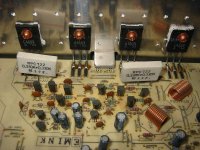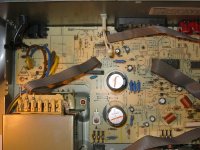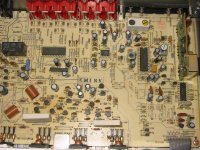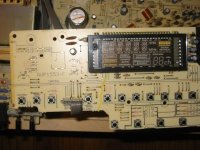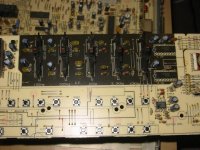I pulled this receiver from a dumpster and hoped to just have to replace the fuse, alas, no. When I replaced the fuse and turned it on I heard the trafo start to hum and then the fuse blew again. I have attached some pictures of the pcbs, does anyone have any idea where to start?
Attachments
Hi
Nice find...now scrap it and use the hardware to build a great DIY amp!!!!😀
Just kidding😛, I would check the most likely reason there is a short and the fuses are blowing, shorted output and possibly the driver transistors. Measure with an Ohm meter the pins and look for a short. Check the collector to emitter pins. Those look like
2SC4688 and 2SA1803
Good luck
Nice find...now scrap it and use the hardware to build a great DIY amp!!!!😀

Just kidding😛, I would check the most likely reason there is a short and the fuses are blowing, shorted output and possibly the driver transistors. Measure with an Ohm meter the pins and look for a short. Check the collector to emitter pins. Those look like
2SC4688 and 2SA1803
Good luck
The first thing you should check is the filter caps in the power supply. Electrolytics tend to go bad as they get old, and when they do, they like to become short circuits. It's also possible that the rectifier bridge diodes (either individual diodes or a bridge pack) may have one or more shorted diodes. If all of these seem to be good, there is something else in there, probably with the amplifier section. But you should check the bridge and the main filter caps in the supply as a start.
Depending on whether you want to go quick and cheap rebuild or audiophile, it may not be very expensive, as long as the transformer isn't bad.
That is one other thing to try, I just thought of, disconnect the secondary wires of the transformer from the PS circuit, making sure the wires don't short, and try replacing the fuse and turning on again. If the fuse doesn't blow, then the tranny is ok, since it has no load at all.
Peace,
Dave
Depending on whether you want to go quick and cheap rebuild or audiophile, it may not be very expensive, as long as the transformer isn't bad.
That is one other thing to try, I just thought of, disconnect the secondary wires of the transformer from the PS circuit, making sure the wires don't short, and try replacing the fuse and turning on again. If the fuse doesn't blow, then the tranny is ok, since it has no load at all.
Peace,
Dave
I heard the traffo start to hum and then the fuse blew again.
indicative of shorted rectifiers, output transistors or combination thereof....
looks to me that the output devices have been replaced before, as the factory usually doesn't glop so much heat sink grease on the transistors. check the output transistors first. if they are bad, begin checking the ones in front of them, and don't forget your bias transistors under the tab on the heat sink (at the bottom of the heat sink in the middle between the output pairs)
Get a 6 foot extension cord and splice in a light socket on the black/hot lead. This limits the current so you don't damage anything else when blowing fuses. If there is a short the light comes on and stays on. If everything is OK the light comes on for a few seconds and then goes dim.
Thanks for the replies, all. My multimeter is over at my brothers house and I'm not sure if I'm going to get it back. Does anyone know of any good deals for one online?
- Status
- Not open for further replies.
- Home
- Amplifiers
- Solid State
- Dumpster Dive Find - Pioneer SX-201 Blowing Fuses
